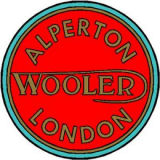

1912 The bike was made by Wilkinson, marketed as the Wilkinson-Wooler TMC and raised to 344cc.
1913 By late in the year the name was back to Wooler, with works in Harrow. The engine had pump lubrication, but the machine remained as before.
Production halted during World War I.
1919. Production resumed and the two-stroke was listed briefly, along with a new, advanced bike that had a 345cc flat-twin four-stroke engine with ioc valves and conventional build. It went into the same type of frame, having plunger suspension front and rear, while the petrol tank continued in the same form. It was entered in the TT, painted yellow and nicknamed the Flying Banana, but without success.
The Wooler Mule cyclecar was announced in February 1919. It was powered by a 1022cc air-cooled HO twin with the cylinders protruding from the sides of the bonnet, and a circular dummy radiator. The engine used rotary valves. It had a double rear wheel giving the impression of a three- wheeler. No prices were published, but contemporary press reports suggested a price of around £130 which had increased to £185 by December. A 1920 catalogue was published, but it contained only a description, no images. Only a two or three prototypes were built.

1921 Late in the year the transmission was changed to three-speed all-chain drive.
There then came a break in production as the company was re-financed and bought by William Dederich, a successful railway contractor.
The company, as the Dederich-Wooler Engineering Company, with John Wooler as Chief Designer and Engineer, then produced machines with both belt- and chain-drive.
1924 The ioe 345cc model was joined by one with full ohv.
1925 That system was also used by a new 499cc flat-twin. Business problems continued and production moved from Alperton to Twickenham, where Grigg Engineering undertook manufacture for a time.
1926 The twins were discontinued and a conventional looking 511cc vertical single with a type of overhead camshaft, three-speed Sturmey-Archer gearbox, rigid frame and girder forks was tried.
More redesigns followed with more innovations until 1930, when the Depression closed the company and the Wooler name dropped out of sight for some time.
1945 Wooler returned in 1945 with a prototype 500cc transverse-four beam engine with the cylinders one on top of the other on each side. The pistons connected to the beam and this to the crankshaft set below the cylinder level. It had direct drive to a four-speed gearbox and shaft final drive. There was also talk of a variable gear and the whole unit went into a duplex frame, having twin plunger boxes on each side for front and rear suspension. The petrol tank again ran round the headstock and had a headlamp fitted in its nose.
It was displayed at the Earls Court show in 1948 and again in 1951 and 1954. However, only half a dozen hand-built machines were ever made and the machine never materialized in production.
The marque disappeared after founder John Wooler died, in 1956.
A Danish marque named Wooler which used the same logo appeared in 1957. They built mopeds using HMW engines.
Sources: Graces Guide, The Motor Cycle
If you have further information or a query related to this page, please contact us